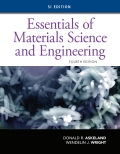
(a)
Interpretation:
The process of annealing heat-treatment needs to be explained.
Concept Introduction:
Heat treatment is a process used to change the materials physical and chemical properties. Metallurgical is the most frequently used applications. In the production of many other products such as glass, heat treatment is used. Heat treatment includes heating or chilling to achieve the required outcome, usually at extreme temperatures.
(b)
Interpretation:
Theaustenitizing heat-treatment process needs to be explained.
Concept Introduction:
Heat treatment is a process used to change the materials' physical and chemical properties. Metallurgical is the most frequently used applications. In the production of many other products such as glass, heat treatment is used. Heat treatment includes heating or chilling to achieve the required outcome, usually at extreme temperatures.
(c)
Interpretation:
The annealing heat-treatment process needs to be explained.
Concept Introduction:
Heat treatment is a process used to change the materials physical and chemical properties. Metallurgical is the most frequently used applications. Many other products, like glass are manufactured using heat treatment. Heat therapy involves cooking or cooling, generally at severe altitudes, to accomplish the necessary effects.
(d)
Interpretation:
Thenormalizing heat treatment process needs to be explained.
Concept Introduction:
Heat processing is used to alter the physical and chemical properties of products. The most common apps are metallurgical. Many other products, like glass heat treatment, are used in the manufacturing of these products. Heat therapy involves cooking or cooling, generally at severe altitudes, to accomplish the necessary effects.
(e)
Interpretation:
Thequenching heat treatment process needs to be explained.
Concept Introduction:
Heat treatment is a process used to change the materials physical and chemical properties. Metallurgical is the most frequently used applications. Many other products, like glass heat treatment, are used in the manufacturing of these products. Heat therapy involves cooking or cooling, generally at severe altitudes, to accomplish the necessary effects.
Want to see the full answer?
Check out a sample textbook solution
Chapter 13 Solutions
Essentials of Materials Science and Engineering, SI Edition
- Find the Thévenin equivalent circuit for the portions of the networks in Figure external to the elements between points a and b. a R₁ 2002 I = 0.1 A 0° Xc : 32 Ω R2 = 6802 20 Ω фъarrow_forwardFind the Norton equivalent circuit for the network external to the elements between a and b for the networks in Figure. E1 = 120 V Z 0° R ww 10 Ω Xc XL · 000 802 802 ① I = 0.5 AZ 60° ZL barrow_forwardPlease do not use any AI tools to solve this question. I need a fully manual, step-by-step solution with clear explanations, as if it were done by a human tutor. No AI-generated responses, please.arrow_forward
- Using superposition, determine the current through inductance XL for each network in Figure I = 0.3 A 60° XL 000 802 XC 502 Ω E 10 V0° =arrow_forwardFind the Thévenin equivalent circuit for the portions of the networks in Figure external to the elements between points a and b. E = 20 VZ0° + R ww 2 ΚΩ Хо XL 000 6ΚΩ 3 ΚΩ b RLarrow_forwardWhat percentage of the full-load current of a thermally protected continuous-duty motor of more than one Hp can the trip current be, if the full-load current is 15 amperes? Ο 122 Ο 140 156 O 170arrow_forward
- How do different urban structures influence a city’s economic health over time? Provide an example of a structure that strengthened or weakened a city.arrow_forwardPlease do not use any AI tools to solve this question. I need a fully manual, step-by-step solution with clear explanations, as if it were done by a human tutor. No AI-generated responses, please.arrow_forwardA biodiesel mixture consisting of 60 mol% methyl oleate (MO), 25 mol% methyl linoleate (ML), and 15 mol% methyl palmitate (MP) is held at 373.15 K and 200 MPa. Given PC-SAFT parameters: segment number \( m_i = [5.7, 6.3, 4.8] \), segment diameter \( \sigma_i = [3.95, 3.98, 3.91] \) Å, dispersion energy \( \epsilon_i/k = [260, 270, 250] \) K, and binary interaction parameters \( k_{ij} = 0.01 \), determine the isentropic speed of sound (m/s) using the PC-SAFT Helmholtz energy formulation and the thermodynamic identity\[c^2 = \left( \frac{\partial P}{\partial \rho} \right)_T + \frac{T \left( \frac{\partial P}{\partial T} \right)_\rho^2 }{ \rho^2 c_v },\]assuming the density is precomputed at 200 MPa and \( c_v \) is obtained from ideal mixing of pure-component values.arrow_forward
- Q3arrow_forwardIn thinkercad can you make a parallel series circuit with a resistors and a voltage source explain how the voltage and current moves through the circuit, and explaining all the components, and if you were to break the circuit to find the current how would you do that? Please show visuals if possible.arrow_forwardIn thinkercad can you make a series circuit with a resistors and a voltage source explain how the voltage and current moves through the circuit, and explaining all the components, and if you were to break the circuit to find the current how would you do that? Please show visuals if possible.arrow_forward
 MATLAB: An Introduction with ApplicationsEngineeringISBN:9781119256830Author:Amos GilatPublisher:John Wiley & Sons Inc
MATLAB: An Introduction with ApplicationsEngineeringISBN:9781119256830Author:Amos GilatPublisher:John Wiley & Sons Inc Essentials Of Materials Science And EngineeringEngineeringISBN:9781337385497Author:WRIGHT, Wendelin J.Publisher:Cengage,
Essentials Of Materials Science And EngineeringEngineeringISBN:9781337385497Author:WRIGHT, Wendelin J.Publisher:Cengage, Industrial Motor ControlEngineeringISBN:9781133691808Author:Stephen HermanPublisher:Cengage Learning
Industrial Motor ControlEngineeringISBN:9781133691808Author:Stephen HermanPublisher:Cengage Learning Basics Of Engineering EconomyEngineeringISBN:9780073376356Author:Leland Blank, Anthony TarquinPublisher:MCGRAW-HILL HIGHER EDUCATION
Basics Of Engineering EconomyEngineeringISBN:9780073376356Author:Leland Blank, Anthony TarquinPublisher:MCGRAW-HILL HIGHER EDUCATION Structural Steel Design (6th Edition)EngineeringISBN:9780134589657Author:Jack C. McCormac, Stephen F. CsernakPublisher:PEARSON
Structural Steel Design (6th Edition)EngineeringISBN:9780134589657Author:Jack C. McCormac, Stephen F. CsernakPublisher:PEARSON Fundamentals of Materials Science and Engineering...EngineeringISBN:9781119175483Author:William D. Callister Jr., David G. RethwischPublisher:WILEY
Fundamentals of Materials Science and Engineering...EngineeringISBN:9781119175483Author:William D. Callister Jr., David G. RethwischPublisher:WILEY





